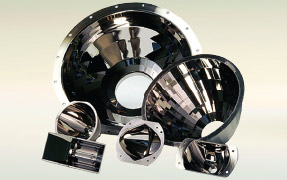Simple thermal imagers use scalable micromechanical arrays
Thermal imaging based on detecting infrared (IR) radiation has revolutionized a variety of challenging tasks ranging from night vision to firefighting, medical diagnostics, and geophysical studies. IR detectors for thermal imaging can be classified broadly as either quantum or thermal detectors, with the latter group including pyroelectric and thermoresistive detectors. Although quantum IR detectors—based on narrow-bandgap semiconductors—offer superior performance, they remain expensive and require cryogenic cooling. This explains the extensive efforts towards developing thermal IR detectors in recent decades. Thermal IR detectors are essentially miniature calorimeters that measure the amount of heat produced in the detector upon absorption of IR radiation.1 They can operate at, or even above, room temperatures. Despite successful commercialization of several detectors suitable for thermal imaging without cooling, the community is still searching for a platform for thermal imagers that combines affordability, convenience of operation, and excellent performance.
We have explored an innovative approach to a thermal imager based on a focal plane array (FPA) of bimaterial microcantilevers that bend when they absorb IR photons.2 The arrangement of our experimental system is depicted in Figure 1. It consists of an IR imaging lens, a microcantilever FPA, and an optical readout. The optical system measures the minute movement of each microcantilever and transforms this information into an optical image projected onto a conventional monochrome CCD or CMOS camera. The dynamic range, intrinsic noise, and resolution of the camera largely determine the performance of this system.

Several research groups have already studied FPAs based on bimaterial microcantilevers and demonstrated their operation as uncooled IR imaging devices.3–5 Our objective was to demonstrate that substantial further advantages can be realized from three areas: rationally-designed micromechanical transducers; streamlined microfabrication; and a highly-efficient optical readout system. The most common approaches to measuring micromechanical responses of bimaterial microcantilevers uses optical, capacitive, piezoresistive, and electron-tunneling transduction effects. Although all of these readout schemes can achieve extremely high sensitivity and acceptably-low noise levels, only optical probing offers contactless readout of micromechanical sensing elements without the need for on-chip electronics and complex wiring architectures. Because we want to minimize fabrication complexity while achieving competitive performance, we devised a process flow that involves only three photolithographic steps and relies on well-established methods of surface micromachining (see Figure 2). Likewise, our prototype employed a very simple optical readout using a low-power non-coherent light source, namely, a diode laser operated below its lasing threshold. The diverging light emitted by this spot source was re-focused by a doublet lens so that it converged to the size of the FPA. The total power of the light beam was 1mW while the power per FPA pixel was a few nanowatts. The light beam reflected off the FPA reached its minimum cross-section at the front plane of the lens mounted on the CCD camera. The small aperture of this lens makes it possible to achieve the required angle-to-intensity conversion.

We were able to image close-to-room-temperature objects without using any advanced data processing. We used a simple background-subtraction algorithm to obtain the image shown in Figure 3. We also characterized our IR imager in terms of two quantifiable figures of merit: the noise-equivalent temperature difference (NETD) and the response time. We found that these parameters are as low as 500mK and 6ms, respectively. These figures of merit are comparable to those of previously implemented uncooled MEMS infrared detectors with significantly higher degrees of fabrication complexity.

We have demonstrated a streamlined approach to a thermal imager with an imaging capability approaching the level required for many applications. Like already-commercialized microbolometer FPAs, our devices do not require cooling and can operate at ambient temperature. More importantly, we achieved this level of performance using an array of simple-geometry pixels fabricated using a straightforward microfabrication process that allows for unlimited scalability. Models of micromechanical FPAs predict2 that they can match or even exceed the performance of more-conventional uncooled IR FPAs, such as those based on microbolometers.6–8
We anticipate that further improvements and refinements in several aspects of the implemented system—such as the image processing, readout, and the detector design itself—will greatly improve the image quality. Refined image processing alone could greatly improve the image quality of our system. It is also possible to employ a self-leveling mechanism9 to reduce susceptibility to ambient thermal fluctuations. The unique and most practically valuable feature of the implemented FPAs, however, is their scalability to high-resolution formats without increasing complexity and cost. Next, we intend to implement a micromechanical FPA capable of thermal imaging with resolution matching or exceeding that of high definition TV.
We would like to acknowledge support from the Defense Advanced Research Projects Agency, the National Science Foundation, and the Department of Energy (DOE). We also would like to acknowledge support from the Pennsylvania State University Electro-Optics Center and L-3 Communications. This work was partially supported by the Laboratory Director's Research and Development Program of Oak Ridge National Laboratory. The Oak Ridge National Laboratory is operated for the U.S. Department of Energy by UT-Battelle under Contract No. DE-AC05-96OR22464.



